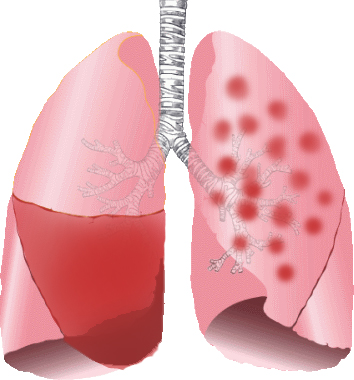Bronchopneumonia or bronchial pneumonia or Bronchogenic pneumonia (not to be confused with lobar pneumonia) is the acute inflammation of the walls of the bronchioles. It is a type of pneumonia characterized by multiple foci of isolated, acute consolidation, affecting one or more pulmonary lobules.
It is one of two types of bacterial pneumonia as classified by gross anatomic distribution of consolidation (solidification), the other being lobar pneumonia.
§Associated conditions

Bronchopneumonia is less likely than lobar pneumonia to be associated with Streptococcus.
The bronchopneumonia pattern has been associated with hospital-acquired pneumonia, and with specific organisms such as Staphylococcus aureus, Klebsiella, E. coli, and Pseudomonas.
In bacterial pneumonia, invasion of the lung parenchyma by bacteria produces an inflammatory immune response. This response leads to a filling of the alveolar sacs with exudate. The loss of air space and its replacement with fluid is called consolidation. In bronchopneumonia, or lobular pneumonia, there are multiple foci of isolated, acute consolidation, affecting one or more pulmonary lobes.
Although these two patterns of pneumonia, lobar and lobular, are the classic anatomic categories of bacterial pneumonia, in clinical practice the types are difficult to apply, as the patterns usually overlap. Bronchopneumonia (lobular) often leads to lobar pneumonia as the infection progresses. The same organism may cause one type of pneumonia in one patient, and another in a different patient. From the clinical standpoint, far more important than distinguishing the anatomical subtype of pneumonia, is identifying its causative agent and accurately assessing the extent of the disease.
§Pathology
.jpg/770px-Bronchopneumonia_(5569078090).jpg)
Multiple foci of consolidation are present in the basal lobes of the human lung, often bilateral. These lesions are 2â€"4 cm in diameter, grey-yellow, dry, often centered on a bronchiole, poorly delimited, and with the tendency to confluence, especially in children.
A focus of inflammatory condensation is centered on a bronchiole with acute bronchiolitis (suppurative exudate - pus - in the lumen and parietal inflammation). Alveolar lumens surrounding the bronchiole are filled with neutrophils ("leukocytic alveolitis"). Massive congestion is present. Inflammatory foci are separated by normal, aerated parenchyma.
§Deaths
.jpg/800px-Bronchopneumonia_(5569078316).jpg)
- Pope Leo X is believed to have died of bronchopneumonia in 1521.
- King Edward VI of England is believed to have died of bronchopneumonia in 1553.
- Carlos Bulosan, novelist died of bronchopneumonia.
- Rosalind Franklin is believed to have died of bronchopneumonia, along with two other diseases.
- Freddie Mercury, the lead vocalist of the rock band Queen, died on November 24, 1991 of AIDS-related bronchopneumonia.
- Myra Hindley, English serial killer, died of bronchopneumonia on November 15, 2002.
- Gregory Peck, American actor, died of bronchopneumonia on June 12, 2003.
- Andrew Carnegie, Scottish-American industrialist
- Julie Vega (1968-1985), Filipino actress, died at the age 16.
- Mary Jane Merrick, mother of Joseph Carey Merrick, known as "The Elephant Man"
- Derrick De Marney, English actor, died of bronchopneumonia and asthma in 1978.
- Elsa Lanchester, actor notable for Bride of Frankenstein, died of bronchopneumonia in 1986.
- Dan O'Connor, Canadian mining prospector, died of bronchopneumonia in 1933.
- Al Capone (Gangster) died of bronchopneumonia Died: January 25, 1947, Palm Island, Miami Beach, FL
- Rufus Ernest Timm (World War 1 Soldier) died of bronchopneumonia on September 23, 1918 in a Naval hospital in New London
§References
§External links
- Bronchopneumonia â€" Causes, Symptoms, Treatment
- Atlas of Pathology
- The Canadian Lung Association - Pneumonia



0 komentar :
Posting Komentar